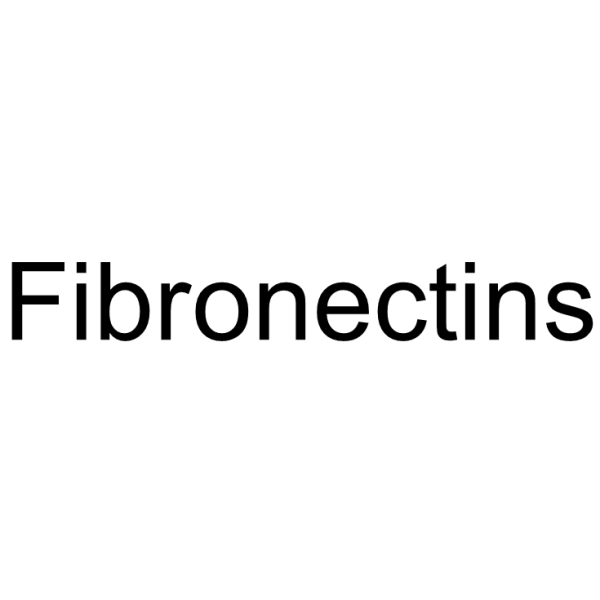粘连蛋白

粘连蛋白结构式

|
常用名 | 粘连蛋白 | 英文名 | Fibronectin |
|---|---|---|---|---|
| CAS号 | 86088-83-7 | 分子量 | N/A | |
| 密度 | N/A | 沸点 | N/A | |
| 分子式 | N/A | 熔点 | N/A | |
| MSDS | 美版 | 闪点 | N/A |
|
Preclinical evaluation of cyclin dependent kinase 11 and casein kinase 2 survival kinases as RNA interference targets for triple negative breast cancer therapy.
Breast Cancer Res. 17 , 19, (2015) Targeted therapies for aggressive breast cancers like triple negative breast cancer (TNBC) are needed. The use of small interfering RNAs (siRNAs) to disable expression of survival genes provides a tool for killing these cancer cells. Cyclin dependent kinase 1... |
|
|
Endothelial cell-derived fibronectin extra domain A promotes colorectal cancer metastasis via inducing epithelial-mesenchymal transition.
Carcinogenesis 35(7) , 1661-70, (2014) Recent evidence has been suggesting the important roles of endothelial cells (ECs) involved in the pathogenesis of several cancers, including colorectal carcinomas (CRCs), but the underlying mechanism remains elusive. We have demonstrated previously that CRC-... |
|
|
Cellular fibronectin containing extra domain A promotes arterial thrombosis in mice through platelet Toll-like receptor 4.
Blood 125 , 3164-72, (2015) Cellular fibronectin containing extra domain A (Fn-EDA+), which is produced in response to tissue injury in several disease states, has prothrombotic activity and is known to interact with Toll-like-receptor 4 (TLR4). The underlying mechanism and cell types i... |
|
|
Atomic Force Microscopy Mechanical Mapping of Micropatterned Cells Shows Adhesion Geometry-Dependent Mechanical Response on Local and Global Scales.
ACS Nano 9 , 5846-56, (2015) In multicellular organisms, cell shape and organization are dictated by cell-cell or cell-extracellular matrix adhesion interactions. Adhesion complexes crosstalk with the cytoskeleton enabling cells to sense their mechanical environment. Unfortunately, most ... |
|
|
Agarose-assisted micro-contact printing for high-quality biomolecular micro-patterns.
Macromol. Biosci. 15 , 613-21, (2015) Micro-contact printing has been developed to print biomolecules, such as cell adhesive molecules, proteins, or DNAs, on a substrate, which can serve as experimental platforms for investigating biological issues and engineering biosensors. Despite the populari... |
|
|
The Hippo pathway effectors YAP and TAZ promote cell growth by modulating amino acid signaling to mTORC1.
Cell Res. 25 , 1299-313, (2015) YAP and TAZ are transcriptional co-activators and function as the major effectors of the Hippo tumor suppressor pathway, which controls cell growth, tissue homeostasis, and organ size. Here we show that YAP/TAZ play an essential role in amino acid-induced mTO... |
|
|
Characterization of G2L3 (GAS2-like 3), a new microtubule- and actin-binding protein related to spectraplakins.
J. Biol. Chem. 286(28) , 24987-95, (2011) The microtubule (MT) and actin cytoskeletons are fundamental to cell integrity, because they control a host of cellular activities, including cell division, growth, polarization, and migration. Proteins involved in mediating the cross-talk between MT and acti... |
|
|
Inhibition of S-adenosylhomocysteine hydrolase decreases cell mobility and cell proliferation through cell cycle arrest.
Am. J. Cancer Res. 5 , 2127-38, (2015) S-adenosylhomocysteine hydrolase (AHCY) hydrolyzes S-adenosylhomocysteine to adenosine and l-homocysteine, and it is already known that inhibition of AHCY decreased cell proliferation by G2/M arrest in MCF7 cells. However, the previous study has not indicated... |
|
|
Extracellular ATP induces intracellular alpha-synuclein accumulation via P2X1 receptor-mediated lysosomal dysfunction.
Neurobiol. Aging 36(2) , 1209-20, (2015) The pathologic hallmark of Parkinson's disease (PD) is the accumulation of alpha-synuclein (αsyn) in susceptible neurons in the form of Lewy bodies and Lewy neurites. The etiology of PD remains unclear. Because brain injury has been suggested to facilitate αs... |
|
|
The sinus venosus contributes to coronary vasculature through VEGFC-stimulated angiogenesis.
Development 141(23) , 4500-12, (2014) Identifying coronary artery progenitors and their developmental pathways could inspire novel regenerative treatments for heart disease. Multiple sources of coronary vessels have been proposed, including the sinus venosus (SV), endocardium and proepicardium, b... |